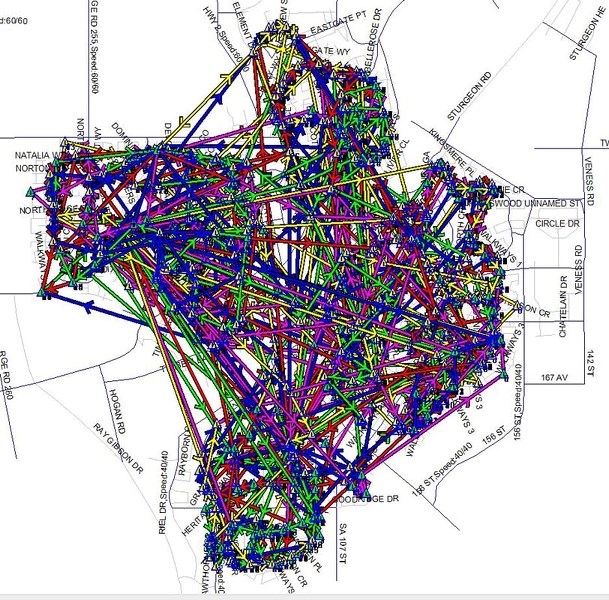St. Albert students who ride the bus will likely spend about a half hour each day sitting in the yellow vehicle that takes them to and from school.
St. Albert students who ride the bus will likely spend about a half hour each day sitting in the yellow vehicle that takes them to and from school. In contrast, it takes months for the transportation managers at both school districts to figure out and outline the multiple bus runs that crisscross the city each morning and afternoon.
“The logistics of transporting 3,200 students is a tough job. That's why the deadline to register as a bus student is June 1,” said Kris Salerno, manager of transportation services for St. Albert Public Schools.
The complication begins with each individual student's needs. Do they wish to take classes in French immersion? Or do they perhaps wish to study in the public district's Logos program or in the Cogito program? Do they need a specific program from one of the city's high schools?
“In our school district there are two French immersion elementary schools and one junior high school and one senior high school that offers that program. Only Leo Nickerson has the Logos program and only Elmer S. Gish has the Cogito program,” said Salerno.
At the senior high level, some programs are offered at Bellerose High and others at Paul Kane. Similarly some options are offered at St. Albert High School and others are available at Ecole Secondaire Sainte Marguerite d'Youville. All these different possibilities for students mean that children may no longer attend the school that's closest to their home.
The close-to-home neighbourhood school isn't even a possibility for children living in Erin Ridge, North Ridge, Oakmont, Inglewood, Kingswood or Heritage Lakes.
“The city has grown and neighbourhoods don't always have a school that can accommodate 600 kids,” Salerno said.
Greater St. Albert Catholic Schools also buses approximately 3,200 children each day within the city as well as in Morinville and Sturgeon County.
Salerno and his counterpart in the Catholic Division, Lauri-Ann Turnbull, work together with the City of St. Albert's Transportation Department and with the bus companies, including First Student Transportation and Cunningham Transportation. Special needs students are transported by Southland Transportation and by Sturgeon Cabs.
Large school buses have a 72-passenger limit, but that maximum is seldom reached. Even so, it's easier to put more students on a bus in the warm months than it is in winter.
“Usually the limit is 60 elementary students and 48 junior and senior high students per bus, sitting two per seat. It's harder when they are wearing heavy parkas,” Salerno said.
The two busiest bused elementary schools in the Protestant system are Leo Nickerson and E.S. Gish. The Gish equation is even more complicated because it is kindergarten to Grade 9.
“There are 14 buses going to each of those schools. Simpson has 15 buses and Paul Kane has 15 as well,” Salerno said.
The average contracted price per bus is $45,000 per year and that cost is subsidized by the provincial government.
“Students' bus passes are funded if they live 2.4 kilometres or more away from their designated school,” Salerno said, as he explained that such students pay $120 per bus pass. If they don't meet the distance requirements the cost per pass is $260.
Still, at $45,000 per bus per year, the transportation costs are large considering that in the public system alone, 44 buses are used. To make the best economic use of each bus, school times in both districts are staggered so that the drivers can make double and even triple runs. The buses pick up the first students for high school shortly after 7 a.m. Then drivers turn around and get the junior students. Some drivers also go to pick up the elementary students in time for school at 9 a.m.
“It is more efficient because rather than using three buses. We also use public transportation routes and city bus stops because they are cleared of snow and the kids don't have to stand in a snow bank,” Salerno said.
With a click of a computer key Salerno can call up any or all of the 105 bus runs that travel through the city each morning and afternoon picking up students for St. Albert Public Schools.
It looks like a rodent maze with buses travelling from students' streets in Kingswood all the way to Bellerose and then circling around to take the younger students from the north end of St. Albert to school in Forest Lawn or Akinsdale. An equivalent maze-like configuration is on Turnbull's computer at the Greater St. Albert School Board office. On any given day there could be half a dozen students at a bus stop, and all of them are going to a different school.
“We have a great relationship with the city and with the Catholic district and it takes a lot of collaboration to make it work,” Salerno said.
